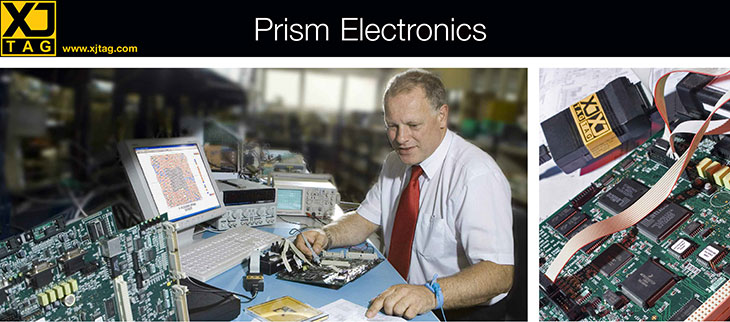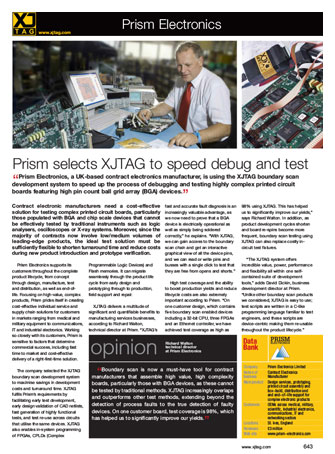Prism Electronics, a UK-based contract electronics manufacturer, is using the XJTAG boundary scan development system to speed up the process of debugging and testing highly complex printed circuit boards featuring high pin count ball grid array (BGA) devices.
Contract electronic manufacturers need a cost-effective solution for testing complex printed circuit boards, particularly those populated with BGA and chip scale devices that cannot be effectively tested by traditional instruments such as logic analysers, oscilloscopes or X-ray systems. Moreover, since the majority of contracts now involve low/medium volumes of leading-edge products, the ideal test solution must be sufficiently flexible to shorten turnaround time and reduce costs during new product introduction and prototype verification.
Prism Electronics supports its customers throughout the complete product lifecycle, from concept through design, manufacture, test and distribution, as well as end-of-life. Focusing on high-value, complex products, Prism prides itself in creating cost-effective individual service and supply chain solutions for customers in markets ranging from medical and military equipment to communications, IT and industrial electronics. Working so closely with its customers, Prism is sensitive to factors that determine commercial success, including fast time to market and cost-effective delivery of a right-first-time solution.
The company selected the XJTAG boundary scan development system to maximise savings in development costs and turnaround time. XJTAG fulfils Prism’s requirements by facilitating early test development, early design validation of CAD netlists, fast generation of highly functional tests, and test re-use across circuits that utilise the same devices. XJTAG also enables in-system programming of FPGAs, CPLDs (Complex Programmable Logic Devices) and Flash memories. It can migrate seamlessly through the product life cycle from early design and prototyping through to production, field support and repair.
XJTAG delivers a multitude of significant and quantifiable benefits to manufacturing services businesses, according to Richard Walton, technical director at Prism. “XJTAG’s fast and accurate fault diagnosis is an increasingly valuable advantage, as we now need to prove that a BGA device is electrically operational as well as simply being soldered correctly”, he explains. “With XJTAG, we can gain access to the boundary scan chain and get an interactive graphical view of all the device pins, and we can read or write pins and busses with a single click to test that they are free from opens and shorts.”
High test coverage and the ability to boost production yields and reduce lifecycle costs are also extremely important according to Prism. “On one customer design, which contains five boundary scan enabled devices including a 32-bit CPU, three FPGAs and an Ethernet controller, we have achieved test coverage as high as 98% using XJTAG. This has helped us to significantly improve our yields”, says Richard Walton. In addition, as product development cycles shorten and board re-spins become more frequent, boundary scan testing using XJTAG can also replace costly in-circuit test fixtures.
“The XJTAG system offers incredible value, power, performance and flexibility all within one self-contained suite of development tools”, adds David Dickin, business development director at Prism. “Unlike other boundary scan products we considered, XJTAG is easy to use; test scripts are written in a C-like programming language familiar to test engineers, and these scripts are device-centric making them re-usable throughout the product lifecycle.”







